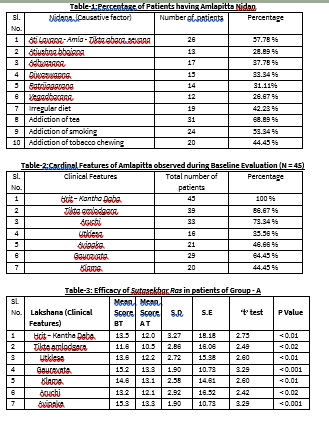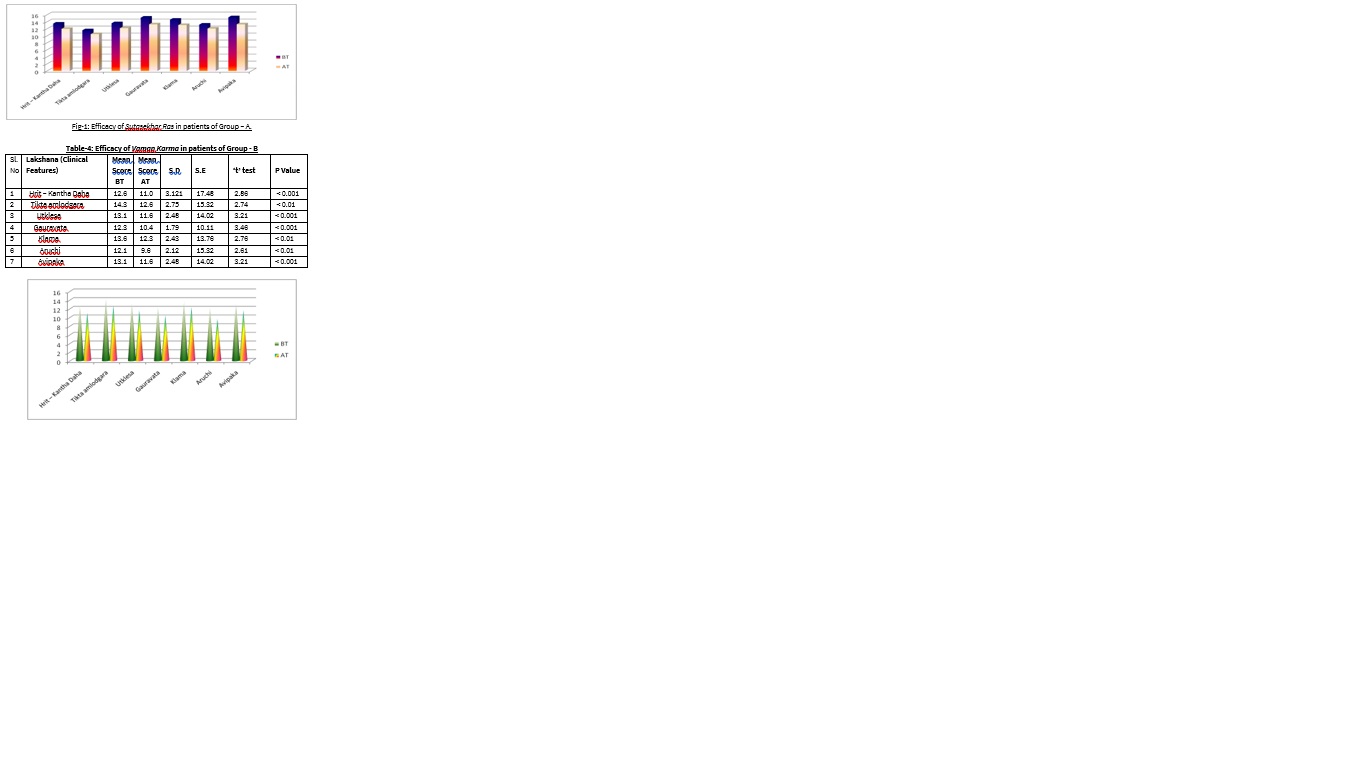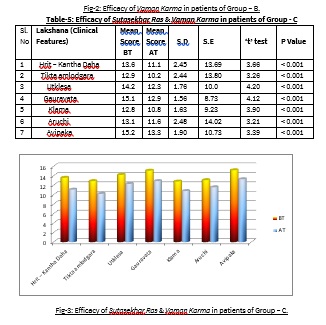Original Article
Year: 2020 |Volume: 1 | Issue: 6 |Pages: 221-229
ROLE OF SUTASEKHAR RAS AND VAMAN KARMA IN AMLAPITTA : AN OBSERVATIONAL STUDY
About Author
Correspondence Address:
Dr. Subhrajyoti Chakraborty Department of kayachikitsa, Dhanwantari bhavan, Banaras Hindu University, Varanasi-221005 Email : ayurvedacharyasubhra@gmail.com Mobile No: 7980816373
Date of Acceptance: 2020-09-21
Date of Publication:2020-10-01
Article-ID:IJIM_30_10_20 http://ijim.co.in
Source of Support: NIL
Conflict of Interest: NIL
How To Cite This Article: Subhrajyoti Chakraborty. Role of Sutasekhar Ras and Vaman Karma in Amlapitta : An Observational Study. Int. J Ind. Med. 2020;1(6):221-229
Abstract
Due to various adoption and changes in life style, food eating habits leads to disproportion of Sharirika doshas, as well as Mansik doshas which leads to various diseases. Ayurveda gives prime supremacy to Agni due to its immense importance in therapeutic, diagnostic and other aspects. Amlapitta or hyperacidity is one of the most common disease seen in present era and not only present but also since past era. Amlapitta, a functional disease of Annavaha srotas caused due to improper dietary habits and stress is prevalent all over the world. Rapid lifestyle provokes people to run behind a busy, stressful life with least concern to proper diets. Amlapitta or hyperacidity therefore is a condition characterized by an increase of sourness and heat in the body. The intensified Pitta dosha harms the digestive fire, leading to improper digestion of food and production of Ama. The present study was intended to find safe and effective treatment of Amlapitta. 45 patients of either sex between 21 – 60 years were randomly selected for the study. In Group A patients were treated with Sutasekhar Ras for 1month. In group B patients were treated with Vaman Karma with Yasthimadhu Kwath and in group C both the therapies were given. The results in group C were highly significant as compared to the other two groups. Thus it can be concluded that Sutasekhar Ras provides soothing effect and Vaman Karma with Yasthimadhu Kwath due to its Kaphapittahara property relieves Amlapitta.
Keywords: Amlapitta,Hyperacidity,Annavaha Srotas, Sutasekhar Ras, Vaman Karma, Yasthimadhu Kwath.
Introduction
Amlapitta is more common in the present situation, may be due to unhealthy diets and regimens. It is the disease which having direct impact of the nutritional faults that a person indulges. In 80% of the top ten life threatening disease of the world are due to faulty dietary habits1. Amlapitta is a disorder of gastro-intestinal tract, as it is described by Kashyap Samhita2, Madhava Nidana3, Bhava Prakasha, Kashyap Samhita4 and Chakradatta. Amlapitta has not given in as disease in Charaka Samhita, Sushruta Samhita and Ashtang Hriday or Ashtang Samgraha. Amlapitta is stated in Brihatrayi as a one of the symptom or complication in many disorders. In modern it is correlated with hyperacidity. Hyperacidity having symptoms may be due to imbalance between the acid secreting mechanism of the stomach. The stomach secretes acid and excess production of acids in stomach is labeled as the hyperacidity. There are variations among different reasons which cause extra acid production. Heartburn and hyperacidity5 are primarily lifestyle or age related.
According to the philosophies of Ayurveda, all the illnesses are due to hypo functioning of Agni.6 According to Acharya Sushruta, inappropriately digested food converts poisonous or toxic (Shukta/ Anna-vish), this toxic-juice /Shukta combines with Pachaka-Pitta and creates a variety of Pitta-dominant diseases7. Amla-pitta is one of them.
Chakrapani8 in his commentary on Charak Samhita defines “Amlapittam Cheti amlagunoundriktam pittam” means the augmented or increased Amla guna of Pitta is known as Amlapitta. According to Shrikanthadutta, his tika Madhukosha vyakhya9 of Madhav Nidan, it is demarcated as “Vidahadhyamla gunaoundrikta pittam amlapittam” i.e. the Pitta converts Vidagdha because of unwarranted upsurge of Amla guna of Pitta & “Amlam vidagdham cha tat pittam amlapittam” the Pitta which attains Amla guna & Vidagdhata is called as Amlapitta. The Samprapti i.e. pathogenesis of Amlapitta involves three important factors10 i.e. Agnimandya, Ama & Annavaha Srotodushti. The main sign and symptoms are Avipaka (indigestion), Klama (tiredness), Utklesa (nausea), Tikta amlodgara (sour and bitter belching), Gauravata (heaviness), Hrit – kantha daha (burning sensation of heart and throat) and Aruchi (anorexia).
From above, we can conclude that increased Drava and Amla Guna of Pachaka Pitta plays an important role in the pathogenesis of Amlapitta. Sneha having qualities of both Kapha and Pittahar, but Sneha is present in Pitta in delicate amount. Sneha makes the function of Mardava (softens the food stuff). Hence, both of them are liable for the pathogenesis of Amlapitta which may be a Pathya Asadhya, Bheshaj Asadhya and Kashtasadhya Vyadhi.
AIMS AND OBJECTIVES
1. A critical study on Amlapitta.
2. Evaluation of the efficacy of Sutasekhar Ras and Vaman in Amlapitta.
3. To compare the effect of both the therapies clinically.
MATERIALS AND METHODS
The present study was a single blinded study. Patients attending the O.P.D. of I.P.G.A.E&R at S.V.S.P, Kolkata, with clinical symptoms of Amlapitta were included in the study. A total of 45 patients in the age between 21 – 65 years of either sex satisfying the inclusion criteria were finally enrolled in the study after baseline screening and after taking written informed consent from the patient. The literary data was taken from various Ayurveda Samhitas, text books, magazine articles etc.
Inclusion Criteria
- Patients between 21 and 60 years age of either sex.
- Presence of cardinal features of Amlapitta.
- Patients not taking any other medicines for Amlapitta.
- Patients willing to participate and chronicity of more than 3 months.
Exclusion Criteria
- Patients with peptic ulcer, duodenal ulcer, carcinoma stomach and cardiac disorders.
- Taking medicines of other systemic diseases like hypertension, diabetes mellitus etc.
Selected patients for the study were randomly divided into three groups with 15 patients in each groups with different level of age, sex, and socio-economic status.
Group A – Patients were treated with Sutasekhar Ras 500mg BDAC with honey for 1 month.
Group B – Patients were treated with Vaman Karma with Yasthimadhu kwath.
Group C – Patients were treated with both Sutasekhar Ras and Yasthimadhu kwath.
Duration of Treatment : 1 month.
Follow up Schedule : Assessment was done in every 7 days intervals.
Assessment Parameter :
Subjective Parameter -As per the classical clinical features of Amlapitta.
Objective Parameter -
1. Haematological – Blood for Hb%, TC, DC, ESR.
2. Biochemical – Blood for FBS, PPBS; to exclude out any other systemic disease.
Statistical Analysis
All the observations were compared and grouping was analyzed statistically in terms of mean, Standard Deviation (S.D.), Standard Error (S.E.). The Student paired ‘t’ test was carried out and the information thus collected were interpreted in terms of level of significance i.e. value (p < 0.05).
OBSERVATION AND RESULT
In the present study it was observed that out of total 45 patients, 25 patients (55.56%) were males and 20 patients (44.44%) were females. Age wise study reveals 13 patients (28.89 %) in age group 21 – 30 years, 17 patients (37.78 %) in 31 – 40 years age, 10 patients (22.22 %) in 41 -50 years age and 5 patients (11.11 %) between 51 – 60 years age. Occupation wise study reveals 17 patients (37.78 %) were Housewives, 15 patients (33.33%) were office workers, 8 patients (17.78%) were labours and 5 patients (11.11 %) were students.
After 1month of treatment, statistically significant improvement were observed in overall all the features of Amlapitta. No significant difference was observed in the change of haematological and biochemical parameter after the administration of drugs.

table 1,2,3

table 4

table 5
Discussion
Amlapitta is produced by intensified Pitta due to excessive intake of pungent and sour food items, alcoholic preparations, salt, hot and sharp stuff. This aggravated Pitta cause burning sensations. To pacify the Pitta, anger, fear, excessive exposure to sun and fire, intake of dry vegetables and alkalis, irregularity in taking food, and all Pitta prakopak factors should be avoided11. Amlapitta is a common gastric problem usually related with food habits and lifestyle. In the present study there were 25 males and 20 females. As per age wise distribution it was observed that maximum patients belonged to age group between 31 – 40 years, as madhyamavastha is considered as Pitta prakopa vaya; so, this age group is more prone to suffer from Pitta predominant diseases. Regarding occupation wise distribution it was observed that out of 45 patients majority of patients were housewives having irregular dietary habits. On analyzing the symptomatology of Amlapitta, Hrit – kantha daha was found to be present in all the cases while Tikta amlodgara in 39 patients (86.67 %), Aruchi in 33 patients (73.34 %), Gauravata in 29 patients (64.45 %), Avipaka in 21 patients (46.66 %), Klama in 20 patients (44.45 %) and Utklesa in 16 patients (35.56 %). In grouping analysis Group – C was seen to be highly significant in alleviating the symptoms of Amlapitta. Significant improvement was observed in all the assessment parameters of Amlapitta following 1 month of drug administration.
Sutasekhar Ras is one of the significant medicines used in Ayurveda, it is act as tenderness, fever, hiccup, headache etc. There are many constituents like Parad, Gandhak, Dhatura, Tamra bhasma, Sankha bhasma and Tankan etc which directly reacts with gastric HCL and neutralize them, so this acts as potent antacid. Sutasekhar Ras is a very commonly used drug in Amlapitta and it helps not only in reducing the symptoms but also maintains the health. This drug is very beneficial in this disease due to multiple actions such as anticholinergic and directly acting antacid. In Urdhwaga Amlpapitta vitiated Kapha and Pitta is the key factor for whole pathological process. Vamana Karma is indicated as Shodhana Karma for Urdhwaga Amlapitta. In Urdhvaga Amlapitta, there is disturbance in Dravata, Ushnata of pachak pitta and Snighdhata of Kledak Kapha. Vaman found to be effective in Urdhwag Amlapitta, because Urdhwaga Amlapitta is the Amashaya janya vyadhi and in Vaman amashayasta doshas are expelled out. As also said by Yogaratnakara “Poorvam tu Vamanam karyam.”Amlapitta is a disease of Amashaya Samudbhava and caused due to vitiation of Kapha-Pitta. In Urdhwaga Amlapitta one should go through the Vamana procedure in patient having strong immunity and will power. If we stop the treatment, the symptoms of disease show relapses. As this disease is chirakari a long duration of treatment is required. Pathyaptya i.e. hetu sevan plays the important role in amalapitta. In initial stages of Amlapitta vitiated Pitta leads to Vidagdhajirna thereby causing inflammation and corrosion of Slesmadhara kala of Amasaya i.e. mucus membrane of stomach and duodenum. So here Vaman was carried out with Yasthimadhu kwath so that it decreases swelling of the mucous membrane in inflammatory conditions.
Conclusion
Amlapitta is a condition of Annavaha srotas which affects the quality of life of patients in Amlpitta causes vitiation of Pitta dosha in the body and leads to the occurrence of disease Amlapitta. Middle aged people are more prone to suffer from this disease as is evident in the present study. Addictions like tea, smoking, consuming excessive spicy, oily and sour foods plays a significant role in aggravating the disease. On the basis of result and statistical data’s obtained it can be said that Group C was highly significant in curing the disease as compared to the other two groups and hence it can be concluded that both the therapies were effective in alleviating the symptoms of the disease. Appropriate quantity and quality of food consumed helps to prevent and control Amlapitta.
References
value="
- Barling E., Brooks A. It’s not your fault: Weight gain, obesity & Addictions, 1st ed; 2010, Denver Outskirts press: page-159.
- Tewari, P. V., Kashyap Samhita of Vriddha Jivakiya Tantra, Reprint edition:2008, Varanasi,Chaukhambha Vishvabharati, Chapter 16/1-30; p.630-638.
- Tripathi, Brahmanand., Madhav Nidaan Madhukosha commentary, Reprint edition: 2002, Varanasi, Chaukhambha Surabharati Prakashan;Part – 2, Chapter 51; p.225.
- Shastri,Laxmipati., Yogaratnakara Vidyotini Hindi Commentary, Edition-2: 2012, Varanasi, Chaukhambha Sanskrit Series; verse 1-3.
- Gaddam, Srinivas., Sharma, Prateek., Shedding light on the epidemiology of GERD in India – a big step forward, Indian J. Gastroenterol, May-June 2011; 30(3): 105-107.
- Krushna,Ganesh., Sartha, Garde., Vagbhata Ashtanga Hridaya with the commentaries, Reprint edition: 2011,Varanasi; Chaukhamba Surbharati Prakashan;Nidana sthana, Chapter 12;p.197.
- Yadavaji, Trikamji Acharya., Sushruta Samhita with Nibandhasangraha Commentary of Shri Dalhanacharya and Nyayachandrika Panjika of Shri Gayadasacharya ,Reprint ed: 2012, Varanasi,Chaukhamba Surbharati Prakashan;Sutra sthana,Chapter 46:verse 501;p.251.
- Sharma, Priyavrat., Chakradutta hindi commentary, Reprint edition:2007, Delhi, Chaukhambha orientalia;Chapter 52/17.
- Upadhyaya,Yadunandana., Madhava Nidana:Madhukosha hindi commentary, Reprint edition: 2013, Varanasi,Chaukhambha Sanskrit Series; chapter 51/ 2.
- Pujari,Shivappa., Shreevathsa, B,Bharathi., Hiremath, KJ, Dileep kumar.. “Gastritis (Amlapitta) – A Case Study”, Journal of Ayurveda and Holistic Medicine (JAHM).2014;2(9):59-60.
- Saroch,Vikas., Singh,Jajbir., “A Review on Ayurvedic Medicines for Amlapitta (Hyperacidity)”, AAMJ 2015; 1 (2):40-2.
"
"

